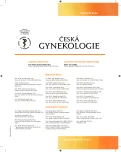Correlation of subjective and objective assessment of vaginal prolapse surgery – secondary analysis of randomized controlled study in patients with pelvic floor injury treated with vaginal mesh or with sacrospinous ligament fixation
Authors:
K. Švabík; R. El Haddad; J. Mašata; Petr Hubka
; A. Martan
Authors‘ workplace:
Gynekologicko-porodnická klinika VFN a 1. LF UK, Praha
přednosta prof. MUDr. A. Martan, DrSc.
Published in:
Ceska Gynekol 2015; 80(5): 351-354
Overview
Objective:
We had provided secondary analysis of our randomized controlled study comparing vaginal mesh with sacrospinous fixation for vaginal prolapse. We correlated data from subjective and objective assessment. Secondly we had provided correlations results of subjective and objective assessment between patient with anatomical failure and those without. The aim of this analysis was to provide correlation between objective and subjective outcome measures.
Design:
Subanalysis of randomized controlled study.
Setting:
Obstetric Gynecology Department, First Faculty of Medicine of Charles University and General University Hospital in Prague.
Methods:
This is secondary analysis of single center randomized controlled study comparing two standard procedures for vaginal prolapse after hysterectomy in patients with levator avulsion injury. We had analyzed pre - and postoperative subjective POPDI score (Pelvic Organ Prolapse Distress Inventory) and correlated this score with most prolapsed portion of vaginal wall. We had compared all vaginal compartments using POPQ (Pelvic Organ Prolapse Quantification): anterior wall with point Ba, apical with point C, and posterior with point Bp. Subsequently we compared subjective POPDI score in group of patients with anatomical failure and those without.
Results:
We had included in randomized study 70 women. Mean preoperative POPDI score was 65.25 (3.57–200). We didn’t found any correlation between subjective score and objective assessment in preoperative data: POPDI vs. Ba (p = 0.75) POPDI vs. C (p = 0.57) a POPDI vs. Bp (p = 0.22) and no correlation in postoperative assessment. Postoperative POPDI score decreased to 26.1, but there was no difference in POPDI score in woman with anatomical failure and no failure – 17.4 vs. 23.3 (p = 0.64)
Conclusion:
Secondary analysis of randomized controlled study had shown that objective and subjective assessment have poor correlation. We didn’t found any correlation between degree of prolapse and intensity of complains. The large inter-individual variability in symptoms and low sensitivity of subjective assessment to detect difference makes subjective assessment as an inappropriate tool as a primary outcome measure of pelvic floor surgery.
Keywords:
subjective assessment, Pelvic Organ Prolapse Distress Inventory, vaginal prolapse, pelvic floor reconstructive surgery
Sources
1. Barber, MD., Kuchibhatla, MN., Pieper, CF., Bump, RC. Psychometric evaluation of 2 comprehensive condition-specific quality of life instruments for women with pelvic floor disorders. Am J Obstet Gynecol, 2001, 185, p. 1388–95.
2. Barber, MD., Walters, MD., Cundiff, GW., P. T. Group. Responsiveness of the Pelvic Floor Distress Inventory (PFDI) and Pelvic Floor Impact Questionnaire (PFIQ) in women undergoing vaginal surgery and pessary treatment for pelvic organ prolapse. Am J Obstet Gynecol, 2006, 194, p. 1492–1498.
3. Dietz, HP., Chantarasorn, V., Shek, LK. Levator avulsion is a risk factor for cystocele recurrence. Ultrasound Obstet Gynecol, 2010, 36, s. 76–80.
4. Dietz, HP., Lekskulchai, O. Ultrasound assessment of pelvic organ prolapse: the relationship between prolapse severity and symptoms. Ultrasound Obstet Gynecol, 2007, 29, p. 688–691.
5. Doaee, M., Moradi-Lakeh, M., Nourmohammadi, A. et al. Management of pelvic organ prolapse and quality of life: a systematic review and meta-analysis. Int Urogynecol J, 2014, 25, p. 153–163.
6. Fitzgerald, MP., Janz, NK., Wren, PA. Pelvic Floor Disorders, Prolapse severity, symptoms and impact on quality of life among women planning sacrocolpopexy. Int J Gynaecol Obstet, 2007, 98, p. 24–28.
7. Ghetti, C., Gregory, WT., Edwards, SR., et al. Pelvic organ descent and symptoms of pelvic floor disorders. Am J Obstet Gynecol, 2005, 193, p. 53–57.
8. Halaska, M., Maxova, K., Sottner, O., et al. A multicenter, randomized, prospective, controlled study comparing sacrospinous fixation and transvaginal mesh in the treatment of posthysterectomy vaginal vault prolapse. Am J Obstet Gynecol, 2012, 207, p. 301 e1–7.
9. Haylen, B.T., de Ridder, SR., Freeman, RM., et al. International Urogynecological, and S. International Continence, An International Urogynecological Association (IUGA)/International Continence Society (ICS) joint report on the terminology for female pelvic floor dysfunction. Neurourol Urodyn, 2010, 29, p. 4–20.
10. Maher, C., Feiner, B., Baessler, K., Schmid, C. Surgical management of pelvic organ prolapse in women. Cochrane Database Syst Rev. 2013, 4: s. CD004014.
11. Svabik, K., Martan, A., Masata, J., et al. Comparison of vaginal mesh repair with sacrospinous vaginal colpopexy in the management of vaginal vault prolapse after hysterectomy in patients with levator ani avulsion: a randomized controlled trial. Ultrasound Obstet Gynecol, 2014, 43, p. 365–371.
Labels
Paediatric gynaecology Gynaecology and obstetrics Reproduction medicineArticle was published in
Czech Gynaecology

2015 Issue 5
Most read in this issue
- Mental changes in women due to the use of hormonal contraception
- Histological types of uterine fibroids in reproductive age and postmenopausal women
- Heterotopic pregnancy after spontaneous conception
- Diaphragmatic surgery in advanced ovarian cancer therapy
